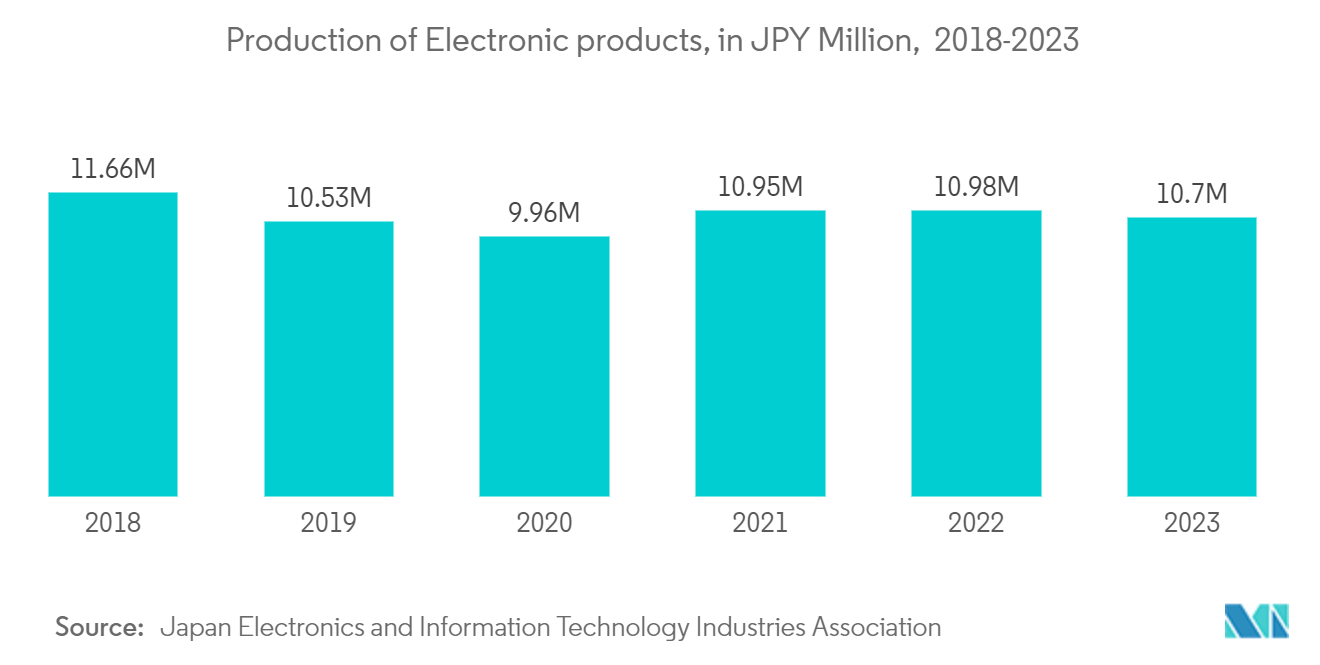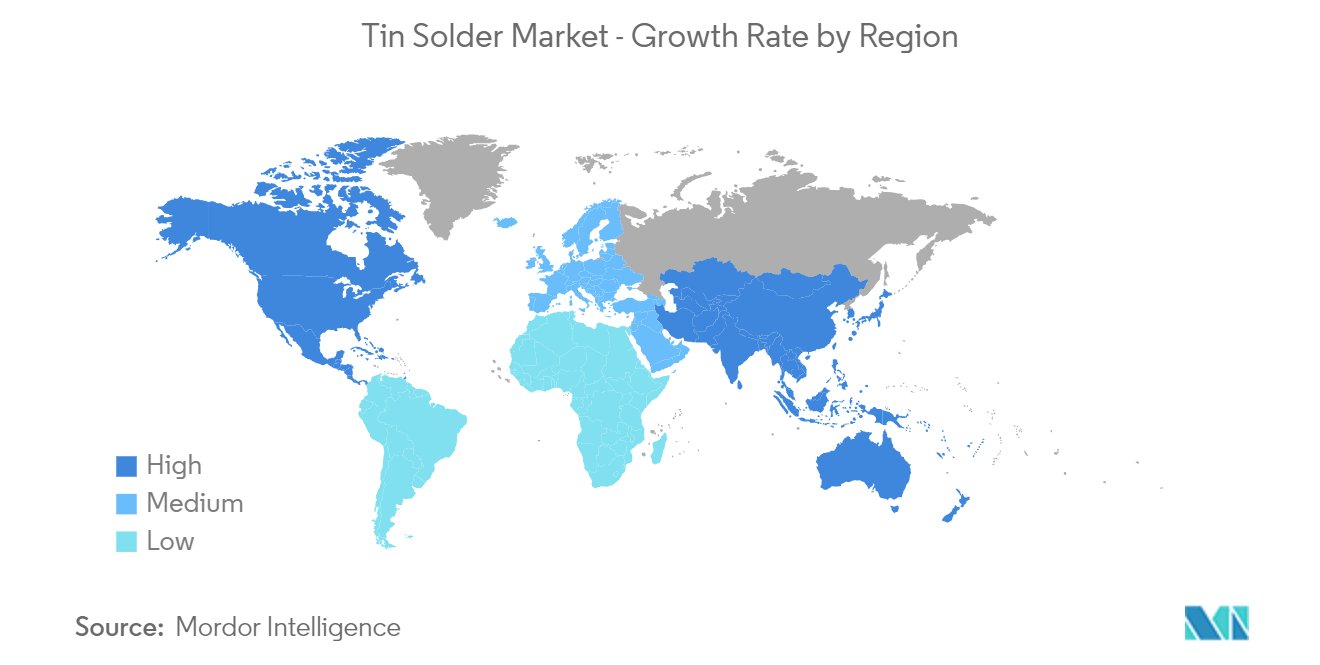Market Trends of Tin Solder Industry
Electronics Segment is Expected to Dominate the Market
- Tin solder plays a critical role in electronics by forming a strong mechanical and conductive connection between electrical components and circuit boards. This allows for the secure attachment of delicate components while ensuring a smooth flow of electricity through the soldered joints. The melting point of tin solder is low enough to avoid damaging heat-sensitive electronic parts during the soldering process.
- Tin-lead wire solder is prevalent in electronics, especially where components are prone to melting, cracking, or warping at high temperatures. It offers good electrical properties and enhances mechanical strength.
- The increasing usage and expanding application scope in the electronics industry are expected to drive the global market for tin solders. The electronics solder is one of the world’s largest and fastest-growing industries. In today’s digital era, electronic devices continue to profoundly impact and shape our lives.
- According to the Japan Electronics and Information Technology Industries Association (JEITA), global electronics production decreased by around 2.5% in 2023, reaching JPY 10,699,267 million (~USD 73,218.96 million) compared to the previous year. However, ongoing efforts to digitally transform society, businesses, and industries and address social issues through innovations like generative AI are expected to drive demand for solution services and rebound the demand for electronic components. In 2024, digitization and the adoption of innovative technologies are poised to accelerate the growth of the global electronics sector, with an anticipated 9% increase to USD 3,690 billion compared to 2023.
- According to the German Electrical and Electronic Manufacturers Association (ZVEI), the global electronics market reached EUR 169.50 billion (~USD 181.87 billion) in 2023. The expanding production of electronics worldwide is forecasted to have a positive impact on the market in the coming years.
- Germany stands out as Europe's electronics powerhouse. The country's electrical and electronics sector, as reported by the Germany Electrical and Electronics Association, dominates Europe and ranks among the world’s top five largest markets, boasting a turnover of EUR 238 billion (~USD 262.66 billion) in 2023. The robust electronics market in Germany is likely to increase the consumption of tin solder, which is essential for producing high-quality electronic devices.
- The electronics manufacturing sector in India has been another major consumer of tin solder in recent times. The country is expected to see a rise in demand for various electronic goods in future years. According to Pankaj Mohindroo, Chairman of the Indian Cellular and Electronics Association, the total production of electronics goods in the financial year 2023-2024 is estimated to reach USD 115 billion.
- Tin solder plays a pivotal role in connecting electrical components and semiconductors to circuit boards. These circuit boards are integral to a wide array of everyday consumer technologies, from phones and TVs to computers, cameras, washing machines, and refrigerators.
- In August 2024, the US Department of Commerce unveiled a USD 1.6 billion investment to bolster Texas Instruments' semiconductor production. Once operational, TI's Sherman facilities are set to produce over 100 million chips daily.
- In July 2024, the Canadian government, through ISED (Innovation, Science and Economic Development Canada), announced to invest USD 120 million in the FABrIC (Fabrication of Integrated Components for the Internet’s Edge) network. This five-year initiative, exceeding USD 220 million, aims to bolster Canada's semiconductor manufacturing and commercialization capabilities.
- Hence, the above-mentioned factors are expected to impact the demand for tin solder in the electronics industry during the forecasted period.

Asia-Pacific Region is Expected to Dominate the Market
- In the Asia-Pacific region, automotive production has seen a growing demand, which had a positive impact on the tin solder market.
- The Asia-Oceania region emerged as the frontrunner in vehicle manufacturing, outpacing other regions. OICA data highlights that automotive production in this region reached 55.11 million units in 2023, up by 10.18% from 2022's 50.02 million units. Notably, this production is largely spearheaded by key players like China, Japan, South Korea, and India.
- According to the China Association of Automobile Manufacturers (CAAM), China has the most significant automotive production base in the world. In 2022, the total vehicle production was 27 million units, an increase of 3.4 % compared to 26 million units produced last year.
- According to the latest data released by the China Association of Automobile Manufacturers (CAAM), car production in the country exceeded 30.16 million units in 2023, registering an 11.6% increase compared to the previous year. A total of 30.09 million units of passenger cars were sold in the country in 2023, registering a nearly 12% increase compared to the previous year.
- According to the data released by the Society of India Automotive Manufacturing (SIAM), 4.58 million automotive vehicles were manufactured in the financial year 2023, compared to 3.65 million vehicles produced in the financial year 2022. The country saw a rise of around 25% in automotive production in 2023 compared to the previous year.
- Tin solder is also used in various other applications, including aerospace and defense, solar, plumbing, roofing, and glass. Soldering in the aerospace and defense industry is a meticulous process that upholds the highest standards of cleanliness, safety, and quality.
- China is a major player in the global aerospace market, excelling in aircraft manufacturing and domestic air travel. The country's aircraft parts and assembly sector is growing rapidly, with over 200 small parts manufacturers. According to the International Trade Administration (ITA), China is the second-largest civil aerospace market globally. As of January 2024, the National Bureau of Statistics of China and the Civil Aviation Administration of China reported 7,351 civil aircraft, an increase of over 550 airplanes from 2022.
- The South Korean Defense Acquisition Program Administration (DAPA) plans to work on light aircraft with an investment of EUR 1.8 billion (USD 1.94 billion), which is expected to be operable in 2033. Hyundai Heavy Industries is involved in this manufacturing process, which requires annual maintenance of EUR 180 million (USD 194.16 million).
- Malaysia is one of the major manufacturers of various electronic products, such as semiconductors, industrial electronics, telecommunications, and consumer electronics. In order to increase the manufacturing of various electronic goods in the country, various manufacturers have started to invest in the country’s electrical and electronics industry. In 2023, a total of USD 18.12 billion worth of investments were approved by the government for the manufacturing of electrical and electronic products in the country.
- All the above-mentioned factors are expected to have a positive impact on the tin solder market in the Asia-Pacific region during the forecast period.


